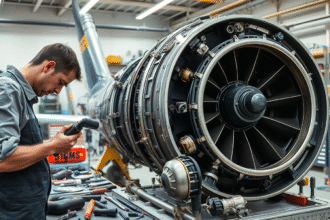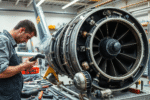Did you hear about the air racing accident at the National Championship Air Races? It happened on September 16, 2022. A crash was very tragic and hit the aviation world hard.
reno air races crash
This event made people worry about the safety of air racing. You’ll learn about what happened before the crash, the crash itself, and the investigation that followed.
Key Takeaways
- The crash occurred on September 16, 2022, during the National Championship Air Races.
- The incident resulted in a significant air racing accident.
- The event raised concerns about the safety of air racing.
- An investigation was conducted to determine the cause of the crash.
- The incident had a profound impact on the aviation community.
The Fatal Incident at the National Championship Air Races
On September 16, 2022, a tragic crash happened at the National Championship Air Races in Reno, Nevada. This event was a sad moment for the annual event of aviation fans and competitors.
Timeline of Events on September 16
The day started with excitement as pilots got ready for the races. The National Championship Air Races were known for thrilling crowds. But this year, it turned deadly.
The crash occurred during the Unlimited Class heat. Witnesses described the scene as chaotic when the aircraft crashed.
Initial Reports and Emergency Response
First Eyewitness Accounts
People heard a loud crash and saw smoke. “It was like a nightmare come true,” said one witness. Emergency teams quickly arrived at the scene.
Official Statements from Race Organizers
Race organizers issued a statement confirming the crash and expressing condolences. They promised a thorough investigation.
Reno Air Races Crash
The emergency response was quick, with medical teams and rescue personnel on the scene fast. The incident showed the need for strong safety measures and emergency plans.
Details of the Reno Air Races Crash: What Happened
The 2022 Reno Air Races crash highlights the need to know about the plane, the pilot, and the weather. It shows how different things came together to cause the tragedy.
Aircraft Specifications and History
The plane was an old model with a long history in racing. Knowing its specs helps us understand what happened before the crash.
Technical Details of the Aircraft
The plane had a strong engine, perfect for racing. Its key specs include:
| Specification | Detail |
| Engine Type | Radial Engine |
| Horsepower | 1,000 HP |
| Propeller Type | 4-Blade Propeller |
Maintenance Records and Pre-Flight Inspections
The plane had been checked thoroughly before the race. Yet, a closer look at these records is needed to find any missed problems.
aircraft specifications
Pilot Background and Racing Experience
The pilot was very experienced in air racing. Their background and skills are key to understanding their actions during the race.
Weather and Course Conditions at Time of Incident
The weather was good on the day of the crash, with clear skies and mild temperatures. But, we must also look at the race track and weather factors to fully grasp what happened.
History and Background of the National Championship Air Races
The National Championship Air Races have been exciting fans for over 50 years. They take place every year in Reno, Nevada. This event draws people from all over the world.
The Evolution of Air Racing in Reno, Nevada, 1964
The Reno Air Races started with a small group of aviation fans. Now, it’s a big event known worldwide. The event has grown a lot, adding new race types and safety steps.
Race Categories and Competition Structure
The National Championship Air Races have different race types. These include:
- Unlimited Class: The fastest piston-engine planes
- Biplane Class: Vintage biplanes
- Jet Class: Modern jet planes
Economic Impact on the Reno Community
The Reno Air Races have a big economic impact on the area. Thousands of people come, helping local businesses a lot. They spend money on tickets, places to stay, and food.
The event also helps keep Reno’s aviation history alive. It’s a key part of the city’s culture.
Immediate Aftermath and Emergency Response
The Reno Air Races crash on September 16, 2022, led to a quick and detailed emergency response. The crash’s severity called for a team effort from first responders, medical teams, and event organizers.
First Responder Actions and Protocols
Firefighters and paramedics were fast to arrive at the scene. They followed well-established protocols to respond quickly and effectively. Emergency services quickly reached the crash site due to planned access routes.
Medical Response and Casualty Management
The medical team’s response was key in handling the crash’s casualties. They provided immediate care and sorted patients based on urgency. Paramedics and medical staff worked efficiently to keep patients stable before moving them to hospitals.
Evacuation Procedures for Spectators and Participants
Evacuation plans were set in motion to keep spectators and participants safe. Event organizers and safety teams led people away from the crash site. Clear communication and signs helped in a smooth evacuation.
Communication Systems During the Emergency
Good communication systems were essential during the emergency. Two-way radios and public address systems helped share important information with responders and the public.
Effectiveness of Emergency Plans
The emergency plans were tested during the response. Though the incident was tragic, the response was mostly effective. This shows the value of detailed planning and regular drills.
Official Investigation Process and Preliminary Findings
The National Transportation Safety Board (NTSB) and Federal Aviation Administration (FAA) started a detailed investigation into the Reno Air Races crash. They aim to find out what caused the accident and any other factors that might have played a role.
NTSB and FAA Investigation Protocols
The NTSB and FAA have set rules for looking into aviation accidents. They first secure the crash site, then gather evidence. They also analyze data from the plane, flight recorders, and what witnesses say.
Evidence Collection and Analysis Methods
Many methods were used to collect and study evidence. This included checking the plane’s remains, looking at maintenance records, and talking to witnesses. The evidence found will be key in figuring out why the crash happened.
Technical Examination of Aircraft Remains
Examining the plane’s remains was a big part of the investigation. This included:
- Flight Data Analysis: They looked at the flight recorder data to see how the plane performed and acted during the race.
- Structural Failure Assessment: They checked the plane’s structure to see if any failures might have led to the accident.
Timeline for Final Report Release
The NTSB and FAA are working hard to finish the investigation quickly. The exact time for the final report isn’t known yet. But it will be detailed and cover everything about the incident, with safety tips for the future.
As the investigation goes on, we’ll get a full report on the Reno Air Races crash. It will help us understand what happened and improve safety in air racing.
Safety Protocols at Air Racing Events
Exploring air racing, it’s key to look at safety steps, like those at the Reno Air Races. These events are fast, so they need strict safety rules to keep everyone safe.
Existing Safety Measures at Reno Air Races
The Reno Air Races have set up many safety steps. They check planes carefully to make sure they’re ready for racing. They also design the race track to lower risks for pilots and fans.
Comparison with International Air Race Standards
Looking at Reno Air Races’ safety with international standards shows their dedication. Many of their safety steps are top choices worldwide. They work with other racing groups to keep getting better.
Post-2011 Safety Improvements and Their Effectiveness
After 2011, the Reno Air Races made big safety upgrades. They improved the race track and how they check planes. These changes have made the event safer over the years.
Course Design and Spectator Protection
The race track’s design is key for keeping fans safe. Reno Air Races use barriers and safe spots for watching to protect spectators.
Aircraft Inspection Requirements
They have strict checks for planes to make sure they’re safe. They look at the engine, the plane’s structure, and other important parts.
Historical Context: Previous Incidents at Air Races
Exploring air racing’s history, we see major accidents that changed the sport. These incidents have shaped safety rules and practices.
The 2011 Reno Air Races Disaster
The 2011 Reno Air Races disaster was a tragic event. On September 16, 2011, a World War II-era P-51 Mustang crashed into the grandstands. It killed 11 people and injured 69 others.
Regulatory Changes Following 2011
After the 2011 disaster, the FAA made new safety rules. These included stricter pilot qualifications, better safety checks, and improved spectator protection.
Similarities and Differences to 2022 Incident
The 2011 and 2022 incidents share some similarities. But, there are also key differences. Knowing these helps us find ways to improve safety.
Other Notable Accidents in Air Racing History
Air racing has seen many accidents over the years. For example, a T-6 aircraft crashed fatally in 1959 at the Reno Air Races. These incidents have led to better safety measures.
Safety Evolution in the Sport Over Decades
Over the years, air racing has gotten safer. This is thanks to stricter rules, better aircraft designs, and improved pilot training. These changes have made the sport safer for everyone involved.
“The key to improving safety in air racing lies in learning from past incidents and continually updating safety protocols.” This approach has greatly reduced the risks at air racing events.
Community Impact and Aviation Industry Reaction
The fatal incident at the National Championship Air Races in 2022 shocked many. It affected the local community, aviation fans, and experts. The news spread far and wide, touching many lives.
Local Reno Community Response
The tragedy hit the Reno community hard. They held vigils and memorial services to remember the victims. The community rallied to support the families and those touched by the crash.
Aviation Enthuasiast Community Perspectives
Aviation fans around the world were saddened. They talked about the risks of air racing and how to make it safer. The crash led to discussions on the sport’s future and possible changes.
Media Coverage and Public Discourse
The media covered the incident extensively. News outlets from all over reported on it. People called for a detailed investigation into the crash.
Social Media Response
Social media was filled with condolences and support. Hashtags about the incident were trending. People shared their thoughts and memories of the event.
Expert Commentary and Analysis
Aviation and safety experts analyzed the crash. They talked about its causes and what it means for air racing. Their opinions were shared in the media and online.
| Community | Immediate Response | Long-term Impact |
| Local Reno | Vigils and memorial services | Support for families and crash investigation |
| Aviation Enthuasiast | Reflection on safety measures | Discussions on the future of air racing |
Memorial Services and Support Networks
Memorial services were held to honor those who lost their lives at the National Championship Air Races. These events brought the community together. They offered support to each other in times of sorrow.
Tributes to Those Lost
The memorial services featured tributes to remember the victims. Family members and friends shared stories and memories of their loved ones. They celebrated their lives and achievements.
Support Systems for Families and Witnesses
Support systems were set up for the families of the victims and witnesses. Counseling services and support groups were available. They helped people cope with their experiences.
Community Healing Initiatives
The community played a big role in healing. Various initiatives supported those affected. Local organizations and community groups worked together to offer assistance and comfort.
Fundraising Efforts for Affected Families
Fundraising efforts were made to help the families of the victims. A table below shows some key fundraising initiatives:
| Fundraising Initiative | Amount Raised | Purpose |
| Community Fund | $100,000 | Support for victim families |
| Aviation Community Fund | $50,000 | Counseling services for witnesses |
| Local Charity Drive | $200,000 | General support and assistance |
These efforts showed the community’s dedication to healing and supporting those affected by the tragedy.
Conclusion: The Future of Air Racing After the Tragedy
The Reno Air Races crash on September 16, 2022, was a sad event. It made everyone think about the future of air racing. It’s clear that safety must come first to protect everyone involved.
The Reno Air Races have a long history of exciting airshows and races. But the 2022 crash showed we need better safety. You can bet the aviation world will work together to make things safer.
As the crash investigation goes on, we’ll see big efforts to make things better. The National Transportation Safety Board (NTSB) and the Federal Aviation Administration (FAA) will be key. They will help shape the future of air racing.
The lessons from the 2022 crash will guide air racing’s future. By focusing on safety, the sport can keep growing and be safer. Looking ahead, the legacy of Reno Air Races will live on, with a strong focus on safety and excellence.
FAQ
What were the circumstances surrounding the Reno Air Races crash on September 16, 2022?
The Reno Air Races crash happened on September 16, 2022. It was a major incident. An investigation was launched to understand what led to the crash.
What was the response of the emergency services to the crash?
Emergency services quickly responded to the crash. They helped those affected and set up evacuation plans. They also used communication systems to manage the situation.
What is the role of the NTSB and FAA in investigating the crash?
The NTSB and FAA led the investigation. They followed strict protocols to collect and analyze evidence. This included examining the aircraft and flight data.
How has the Reno Air Races crash impacted the sport of air racing?
The crash made everyone rethink safety in air racing. It compared safety measures to international standards. It also looked at how safety has improved over the years.
What safety measures are in place at the Reno Air Races?
The Reno Air Races have many safety measures. These include designing the course and protecting spectators. They also inspect aircraft and have emergency plans in place. These are regularly updated.
How has the local community responded to the crash?
The Reno community has rallied around the families affected. They have held memorial services and set up support networks. They have also raised funds to help.
What is the significance of the Reno Air Races to the aviation community?
The Reno Air Races are a big deal in aviation. They attract fans and professionals. They also boost the local economy.
How do the Reno Air Races compare to other air racing events in terms of safety?
The Reno Air Races are compared to other events for safety. The goal is to find the best safety practices. This helps improve safety in air racing.
What are the potentially long-term implications of the Reno Air Races crash for the sport?
The crash could lead to big changes in air racing. This includes new safety rules, aircraft designs, and pilot training. The aviation world is learning from the incident.







